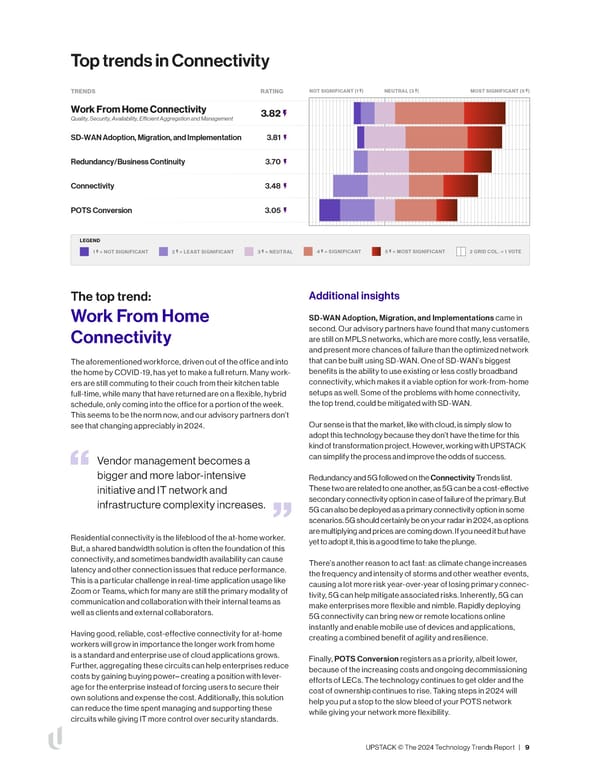Top trends in Connectivity The top trend: Additional insights Work From Home SD-WAN Adoption, Migration, and Implementations came in second. Our advisory partners have found that many customers Connectivity are still on MPLS networks, which are more costly, less versatile, and present more chances of failure than the optimized network The aforementioned workforce, driven out of the office and into that can be built using SD-WAN. One of SD-WAN’s biggest the home by COVID-19, has yet to make a full return. Many work- benefits is the ability to use existing or less costly broadband ers are still commuting to their couch from their kitchen table connectivity, which makes it a viable option for work-from-home full-time, while many that have returned are on a flexible, hybrid setups as well. Some of the problems with home connectivity, schedule, only coming into the office for a portion of the week. the top trend, could be mitigated with SD-WAN. This seems to be the norm now, and our advisory partners don’t see that changing appreciably in 2024. Our sense is that the market, like with cloud, is simply slow to adopt this technology because they don’t have the time for this kind of transformation project. However, working with UPSTACK Vendor management becomes a can simplify the process and improve the odds of success. bigger and more labor-intensive Redundancy and 5G followed on the Connectivity Trends list. initiative and IT network and These two are related to one another, as 5G can be a cost-e昀昀ective infrastructure complexity increases. secondary connectivity option in case of failure of the primary. But 5G can also be deployed as a primary connectivity option in some scenarios. 5G should certainly be on your radar in 2024, as options are multiplying and prices are coming down. If you need it but have Residential connectivity is the lifeblood of the at-home worker. yet to adopt it, this is a good time to take the plunge. But, a shared bandwidth solution is often the foundation of this connectivity, and sometimes bandwidth availability can cause There’s another reason to act fast: as climate change increases latency and other connection issues that reduce performance. the frequency and intensity of storms and other weather events, This is a particular challenge in real-time application usage like causing a lot more risk year-over-year of losing primary connec- Zoom or Teams, which for many are still the primary modality of tivity, 5G can help mitigate associated risks. Inherently, 5G can communication and collaboration with their internal teams as make enterprises more flexible and nimble. Rapidly deploying well as clients and external collaborators. 5G connectivity can bring new or remote locations online instantly and enable mobile use of devices and applications, Having good, reliable, cost-effective connectivity for at-home creating a combined benefit of agility and resilience. workers will grow in importance the longer work from home is a standard and enterprise use of cloud applications grows. Finally, POTS Conversion registers as a priority, albeit lower, Further, aggregating these circuits can help enterprises reduce because of the increasing costs and ongoing decommissioning costs by gaining buying power– creating a position with lever- efforts of LECs. The technology continues to get older and the age for the enterprise instead of forcing users to secure their cost of ownership continues to rise. Taking steps in 2024 will own solutions and expense the cost. Additionally, this solution help you put a stop to the slow bleed of your POTS network can reduce the time spent managing and supporting these while giving your network more flexibility. circuits while giving IT more control over security standards. UPSTACK © The 2024 Technology Trends Report | 9
 The 2024 Technology Trends Report UPSTACK Page 9 Page 11
The 2024 Technology Trends Report UPSTACK Page 9 Page 11